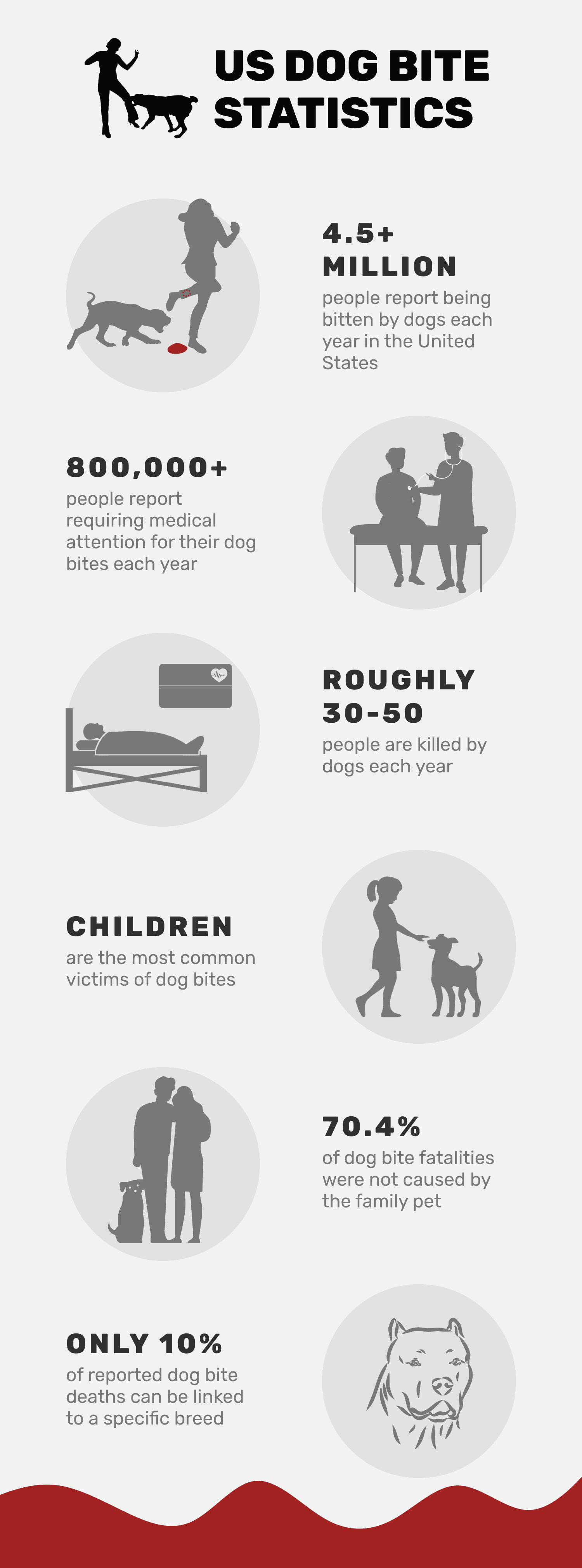Click to Skip Ahead
Note: This article’s statistics come from third-party sources and do not represent the opinions of this website.
A dog may be a human’s best friend, but even best friends can go through rough spells. In the case of dogs, those rough spells, unfortunately, often equal attacks and bites. This can cause some worry if you’re a first-time dog owner. Of course, you want to make sure you and your family, especially your children, won’t be put at risk by your dog. To help ease your mind, here are some dog bite and attack statistics for the United States, including what breed of dog bites the most based on the available information.
However, these statistics don’t tell the full story about whether or not a dog will bite, and we’ll talk more about that later.
The 20 Dog Bites Statistics
- According to CDC dog bite statistics, more than 4.5 million people report being bitten by dogs each year in the United States.
- More than 800,000 people per year report requiring medical attention for their dog bites.
- About 30–50 people are killed by dogs each year.
- Children are the most common victims of dog bites.
- Between 2000–2018, 45.9% of dog bite deaths occurred in people under 16 years old.
- Over 13 years, the highest percentage of dog bite deaths were in children 2 years old or younger.
- Dog bite injuries in children increased during 2020 and the coronavirus pandemic.
- California and Texas reported the most dog bite fatalities between 2005–2017.
- More than 25 breeds were responsible for dog attack fatalities over the 20 years examined by this study.
- 4% of dog bite fatalities were not caused by the family pet.
- In 2019, only 10% of the reported dog bite deaths could be linked to a specific breed.
- Pit Bull-type dogs and Rottweilers were held responsible for 75% of the fatal attacks where the breed was identified.
- Dogs with short, wide heads who weigh between 66–100 pounds are most likely to bite.
- The three breeds with the highest percentage of reported dog bites in one study were Pit Bulls, mixed breeds, and German Shepherds.
- A survey conducted in Colorado in 2007–2008 found that Labrador Retrievers were responsible for the most dog bites in the state during that year.
- More than 700 cities have breed-specific laws or breed bans as of 2020.
- $1.13 billion was paid by insurance companies for dog bite injuries in 2022.
- The average cost for a dog bite insurance claim in 2022 was $64,555.
- More than 900 ER visits per day are for dog bite injuries.
- 9,500 people per year are hospitalized for dog bites.

How Many Dog Bites Happen Each Year And Who Is Bitten
1. More than 4.5 million people report being bitten by dogs each year in the United States, according to CDC dog bite statistics.
(AVMA, CDC)
Most dog bite data relies on attacks that are reported to authorities or generate medical information. Dog bites that cause minimal damage or donʻt result in a doctor visit are likely to go unreported.
There are 85–90 million pet dogs in the United States, and the vast majority do not cause dog bites or attacks.

2. More than 800,000 people per year report requiring medical attention for their dog bites.
(CDC, AVMA)
These numbers include hospitalized people and those who only required outpatient care. According to reported stats, about 1 in 5 people who are bitten require medical care.
3. About 30–50 people are killed by dog attacks each year.
(AP News)
Of the 4.5 million dog bites per year, 0.00001% are fatal. Fatal dog attacks get all the publicity, but they are just a fraction of the story.

4. Children are the most common victims of dog bites.
(AVMA)
Not only are children the most likely to be the victim of a dog bite, but they are also more likely to be severely injured. Most children are bitten by dogs they know and during normal daily activities.
5. Between 2000–2018, 45.9% of dog bite deaths occurred in people under 16 years old.
(AVMA)
Children and teenagers are by far the most likely to suffer fatal dog bite injuries. Much of the focus of preventing dog bites and attacks focuses on educating children on how to properly interact with dogs.
6. Over 13 years, the highest percentage of dog bite deaths were in children 2 years old or younger.
(DogsBite.org)
Babies and toddlers are most vulnerable to dog bite deaths due to their size and behavior. Dogs should never be left alone with young children because of this.
(PubMed, Journal of Pediatrics)
A study from Colorado found that dog bite injuries in kids increased by almost 300% while the state was under stay-at-home orders for the COVID-19 pandemic. The authors suspect several reasons for this increase, including increased stress for both kids and dogs, less adult supervision, and an increase in the amount of time kids and dogs spent together.

8. California and Texas reported the most dog bite deaths between 2005 and 2017.
(DogBites.org research)
These two states also have the most people, which likely relates to the dog bite statistics.
 Dog Bites and Deaths Breed Statistics
Dog Bites and Deaths Breed Statistics
9. More than 25 different breeds caused dog attack deaths over 20 years.
(CDC)
The breeds included the usual suspects—Pit Bulls and Rottweilers—to others less commonly thought dangerous including Retrievers, Hounds, and even one Cocker Spaniel. Wolf-dog hybrids accounted for some deaths as well.

10. 4% of dog bite deaths were not caused by family pets.
(Canine Research Council)
The Canine Research Council distinguishes between dogs kept as family pets, meaning they live with and bond with the family, and what they call “resident dogs.” Resident dogs refer to dogs who are owned but who donʻt regularly interact with people in a positive way, such as dogs tied up in the backyard or confined to a kennel. These dogs behave differently around humans than family pets and are responsible for most deadly dog attacks.
11. In 2019, only 10% of dog bite deaths could definitely be linked to a specific breed.
(Canine Research Council)
The Canine Research Council has been producing yearly reports on dog bite deaths for two decades and continually finds that only a small percentage of these deaths can be linked to a breed. Often, they find that bias toward certain breeds results in the misidentification of offending dogs.

12. Pit Bull-type dogs and Rottweilers were held responsible for about 75% of dog bite deaths where the breed was identified.
(CDC)
The CDC data on dog deaths over 20 years found that Pit Bull-type dogs were believed to have committed about 66% of the attacks and Rottweilers about 10%. The Canine Research Council is much stricter in its criteria, requiring genetic proof of the dogʻs breed to draw evidence-based conclusions. The CDC study relied on visual identification only and admitted that such breed identifications can be problematic and biased.
13. Dogs with short, wide heads who weigh 66–100 pounds are most likely to bite.
(AAHA, International Journal of Pediatric Otorhinolaryngology (IJPO)
If this seems random and wildly specific, well, you are not wrong. This study examined 30 years of scientific papers and searched for reports that named the breed involved in dog bite attacks. They found that the breed most likely to bite was “unknown,” but they could use other factors like weight and head shape to predict which dogs were most likely to bite.

14. The three breeds with the highest percentage of reported dog bites were Pit Bulls, mixed breeds, and German Shepherds.
(AAHA, IJPO)
The same study found while reviewing the literature that these three breeds were responsible for the highest percentage of reported dog bites.
15. A survey conducted in Colorado in 2007–2008 found that Labrador Retrievers were responsible for the most dog bites.
(Denver Post)
This information came from a Colorado group of veterinarians and animal care professionals dedicated to helping humans and dogs live safely. Interestingly, they found that Labs accounted for the highest percentage of bites, about 13%.
16. More than 700 U.S. cities have breed-specific laws or breed bans as of 2020.
(ASPCA)
Breed-specific laws and breed bans are what happens when dog bite data and statistics are taken out of context. A host of expert sources, including the AVMA and the CDC, have concluded that the dog’s breed is not the deciding factor in whether or not a dog is dangerous or prone to bite. However, rather than look at each case individually, some cities and states look at the number of dog attacks attributed to Pit Bulls and just decide to ban all Pit Bulls.
 The Costs of Dog Bite Attacks
The Costs of Dog Bite Attacks
17. $1.13 billion was paid by insurance companies for dog bite injuries in 2022.
(Insurance Information )
This is a 28% increase over the amount paid out in 2021. However, there was a 2% decrease in the number of dog bites and dog-related injury claims from 2021.

18. The average cost of a dog bite insurance claim in 2022 was $64,555.
(Insurance Information Institute)
This number is an increase of 32% compared to 2021. Again, dog bites don’t just impact the human victim and the dog, which is why dog bite prevention is a public health concern.
19. More than 900 ER visits per day are for dog bite injuries.
(Journal of Pediatrics)
ER visits are expensive, especially without health insurance. Besides the financial cost of the dog bite, victims suffer physical costs from the pain and possibly mental and emotional costs as well.

20. 9,500 people per year are hospitalized for dog bites.
(CDC)
Children may be more likely to get bitten by dogs, but people over 25 are more likely to wind up in the hospital because of them.
Frequently Asked Questions About Dog Bite and Dog Bites By Breed
What Dog Breed Is the Most Likely to Bite?
The answer to this question canʻt be determined based on research. But wait, you say, you just told me all these percentages and numbers of bites and attacks attributed to certain breeds. True, but we also mentioned that this data is likely flawed in certain ways, which makes drawing conclusions hard.
To truly determine the likelihood of one breed biting versus another, we need to know the number of biting dogs AND the total number of dogs of that breed. In the Colorado survey, for example, they found about 268 Labradors had bitten someone. But they donʻt know how many Labradors live in the state and therefore canʻt say with certainty, “This percentage of Labradors bite, and this is how likely they are to bite based on other breeds.”
Until dogs undergo a census every 10 years like humans, we won’t have the data to say for sure which breed is most likely to bite.
Why Does It Seem Like Pit Bulls Are the Most Dangerous Dog Breeds?
Again, looking purely at the numbers with no context, it appears that Pit Bulls and Pit Bull-type dogs are the most likely to bite and the most likely to kill someone. However, the reasons behind those numbers are more complicated.
Like all dogs, Pit Bulls are a product of their environment and training. Unfortunately, many Pit Bulls are deliberately encouraged or trained to be aggressive. Some are not trained to learn the right way to interact with people.
Pit Bulls score highly on temperament testing, performing better than traditionally friendly breeds like the Bernese Mountain Dog and Collie. They also score much higher than Chihuahuas, a breed unlikely to appear on many bite reports but whom most veterinary technicians are much less likely to want to deal with than a Pit Bull!

So, If Not Breed, What Determines Whether a Dog Is Likely to Bite?
The AVMA doesnʻt consider the breed a reliable indicator in determining whether a dog will bite.
- Training
- Sex of the dog
- Owner behavior
- Whether the dog is neutered
- Whether the dog lives in a rural vs urban area
- Breed ownership trends over time
This information is why the AVMA and others oppose breed-specific legislation as a way to deal with the issue of dog bites and attacks.
How Do I Avoid a Dog Bite?
- Education: Teaching people why dogs bite and teaching children the right way to interact with a dog
- Responsible Pet Ownership: Encouraging spay/neuter and dogs being kept as family pets instead of resident dogs
- Avoiding Risky Situations: Knowing what situations might lead to bites and how to avoid them, such as not taking toys or treats from a dog or reaching over a fence to pet one.
How Do I Keep My Dog From Biting Anyone?
Even if you have an incredibly friendly pup, don’t assume they’ll never bite anyone. As the AVMA clearly states, any dog can bite under the right circumstances. However, you can reduce the likelihood that your dog bites in several ways. Make sure your dog is spayed or neutered. Train and socialize your dog from an early age so they understand how to interact with people and are under control
Donʻt let your dog escape your property; most dog bites happen when dogs are unrestrained and away from their property. Keep your dog in a fenced-in yard or only walk them on a leash. Responsible owners play a vital role in helping prevent dog bites, and it is important that you do your part.
- You may also want to read: How to Clean a Dog Bite (7 Simple Steps)
Conclusion
Dog bites and attacks are a matter of serious public health concern based on how many occur each year. While we can look at numbers and draw conclusions about certain breeds of dogs, the truth is that preventing dog bites is much more complicated than just regulating or banning certain breeds. If you are in the market for a new dog, look at the whole picture before you dismiss some breeds as undesirable.
Featured Image Credit: meawtai99, Shutterstock












